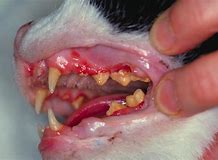As seen in Petrax
Cat periodontal disease, or gum disease in cats, is an inflammation of some or all of a tooth’s deep supporting structures. It is one of the most common diseases in cats today.
If food particles and bacteria are allowed to accumulate along a cat’s gumline, it can form plaque, which, when combined with saliva and minerals, will transform into calculus (tartar). This causes gum irritation and leads to an inflammatory condition called gingivitis.
Gingivitis, which is evidenced by a reddening of the gums directly bordering the teeth, is considered to be an early stage of periodontal disease in cats.
After an extended period, the calculus eventually builds up under the gum and separates it from the teeth. Spaces will form under the teeth, fostering bacterial growth.
Once this happens, the cat has irreversible periodontal disease. This usually leads to bone loss, tissue destruction and infection in the cavities between the gum and teeth.
Symptoms and Types of Gum Disease in Cats
Periodontal disease in cats generally begins with the inflammation of one tooth, which may progress if not treated during different stages of the condition.
A cat with stage 1 periodontal disease in one or more of its teeth, for example, will exhibit gingivitis without any separation of the gum and tooth.
Stage 2 is characterized by a 25 percent attachment loss, while stage 3 involves a 25 to 30 percent attachment loss.
In stage 4 of cat periodontal disease, which is also called advanced periodontitis, there is more than a 50 percent attachment loss. In the most advanced stage of the disease, the gum tissue will usually recede and the roots of the teeth will be exposed.
Cats may also develop a cat gum disease called stomatitis (gingivostomatitis). Stomatitis is the severe inflammation of all of the gum tissue, which may affect the other tissues in the mouth.
Stomatitis occurs due to an overactive immune response to even small amounts of plaque and calculus.
Causes of Gum Disease in Cats
Cat periodontal disease can be caused by a variety of factors, but is most commonly associated with bacterial infection. Bacteria under the gumline leads to pain and inflammation of the tissue.
There may also be a relationship between having a history of calicivirus infection and severe gingivitis.
Diagnosis of Periodontal Disease in Cats
In the exam room, your veterinarian will look inside your cat’s mouth for red, inflamed gums. That is the first indication of a problem. Your veterinarian may press gently on the gums to see if they bleed easily, which is a sign that a deep dental cleaning, or more, is needed.
Once under anesthesia, the diagnosis of cat periodontal disease involves a number of procedures. If periodontal probing reveals more than one millimeter of distance between the gingivitis-affected gum and tooth, a cat is considered to have some form of periodontal abnormality.
X-rays are extremely important in diagnosing periodontal disease in cats because up to 60 percent of the symptoms are hidden beneath the gumline.
In the disease’s early stages, X-rays will reveal loss of density and sharpness of the root socket (alveolar) margin. In more advanced stages, it will reveal loss of bone support around the root of the affected tooth.
Treatment
The specific treatment for cat periodontal disease depends on how advanced the disease is. In the early stages, treatment is focused on controlling plaque and preventing attachment loss.
This is achieved through daily brushing with pet-safe toothpaste, professional cleaning and polishing, and the prescribed application of fluoride or other pet prescription products to minimize the development of plaque.
Sometimes it is necessary to remove the teeth associated with severe stomatitis.
In the more advanced stages, bone-replacement procedures, periodontal splinting and guided tissue regeneration may become necessary.
Living and Management
Follow-up treatment for periodontal disease in cats consists mostly of maintaining good cat dental care and taking your cat for weekly, quarterly or biannual checks.
The prognosis will depend on how advanced the cat gum disease is, but the best way to minimize the adverse effects caused by the disease is to get an early diagnosis, adequate treatment and proper therapy.
Prevention
The best prevention for cat gum disease is to maintain your pet’s good oral hygiene and to regularly brush and clean her mouth and gums.
Cats can be trained to accept brushing when trained slowly over time and rewarded for their cooperation.
Prescription cat food dental diets are available for those cats who are unwilling to have their teeth brushed.
Cat dental treats, water additives and other products certified by the Veterinary Oral Health Council (VOHC) are also shown to help reduce plaque and calculus.
